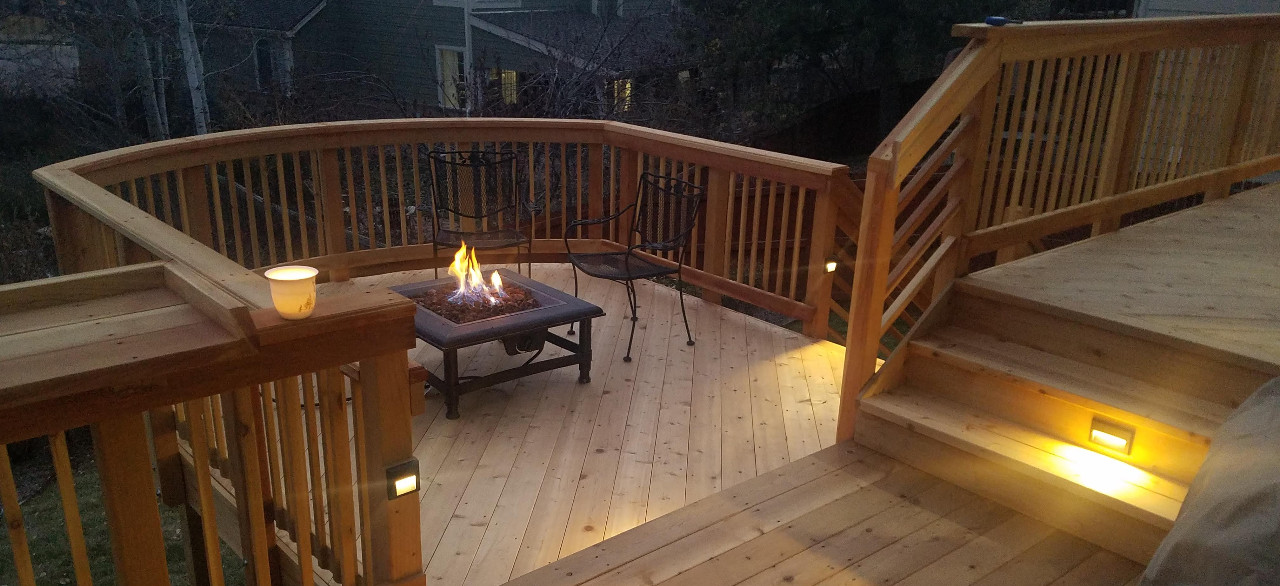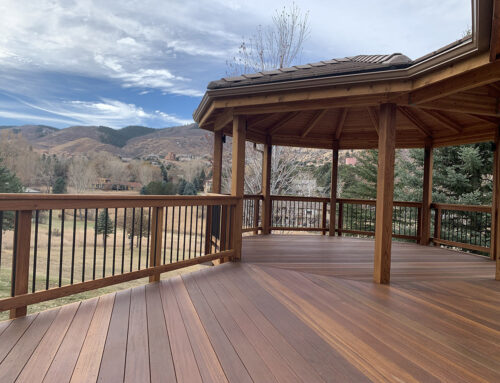When it comes to “fire on deck” and staying warm, there’s something for every need – from a fire pit to fireplaces and heaters. DeckTec can make it happen.
“There’s been a big evolution in all of this since the first outdoor fire options came on board in the late 90s and early 2000s,” Steve Sparhawk, owner of DeckTec said.
(Download: The Ultimate Guide to Starting Your Custom Outdoor Deck Project)
“Fire pits warm the lower body, whereas fire tables, when you sit around them, warm the upper body,” Dave Hall, owner of Colorado Comfort Products, said. “A lot of people prefer a fire pit because of that lower body warmth.” Fire pits are great because they can also double as a coffee table.
Hall said that he sells five times more fire pits than tables.
“The advantage of fire tab les is that they provide warmth around an eating surface,” he said. They come in many different shapes, styles, colors and heights. If people don’t like the appearance of the typical stainless steel, he added, there’s faux “wood” concrete designed to blend in with the wood of your deck.
les is that they provide warmth around an eating surface,” he said. They come in many different shapes, styles, colors and heights. If people don’t like the appearance of the typical stainless steel, he added, there’s faux “wood” concrete designed to blend in with the wood of your deck.
These fire fixtures are growing in popularity, and they’re safe – because they’re gas, they don’t put off any sparks. The fire is controlled.
Fire media, the material that distributes the flame, is abound in variety. There’s colored glass, river rock of all shapes, colors and textures, and traditional logs. The glass is tempered, and the rocks and logs are made out of a special ceramic material designed to withstand the heat without breaking.
There’s granite, tile, and lots of beautiful options for fireplaces. While these products are durable, Hall nonetheless recommends shielding fixtures with fitted covers in the winter to keep snow and weather out.
Fire pits, tables, and bowls range in price from $1,500-4,000, and are powered by natural gas or propane. “You can connect to the natural gas of your house,” Hall said, or if that’s not feasible, portable propane barbecue grill tanks are another option.
At $5,000-10,000, outdoor fireplaces are a bigger investment, but they provide privacy and can be used to block an undesirable view, such as your neighbor’s trampoline or RV. Permanently installed and made of ceramic material, they do offer some heat, but it’s more concentrated, not the 360-degree heat of pits, tables and bowls.
(More: Outdoor Heating for Your Deck)
“The amount of heat you get from a fireplace is going to depend largely on how close you’re sitting to it,” Sparhawk said.
For the most consistent warmth year-round, heaters are your best bet.
“Our heater thing just exploded 5 or 6 years ago – I guess people just want to live outside! Heaters can extend outdoor living by more than three months. Days in the fall and spring that get too cold, just like restaurants will have heaters outside, people are doing that in their homes,” Hall said.
Mounted on walls or ceilings with minimal clearance, infrared heaters are the gold standard, offering unobtrusive, noncombustible, efficient radiant heat. Gas heaters are an option if a home’s electric capacity is tapped out, but gas heaters are noisy, require considerably more clearance, and are less efficient, heating the air before heating you and your furnishings.
“Now we have endless customization, just an infinite number of options for year-round deck enjoyment,” Sparhawk said.







Leave A Comment